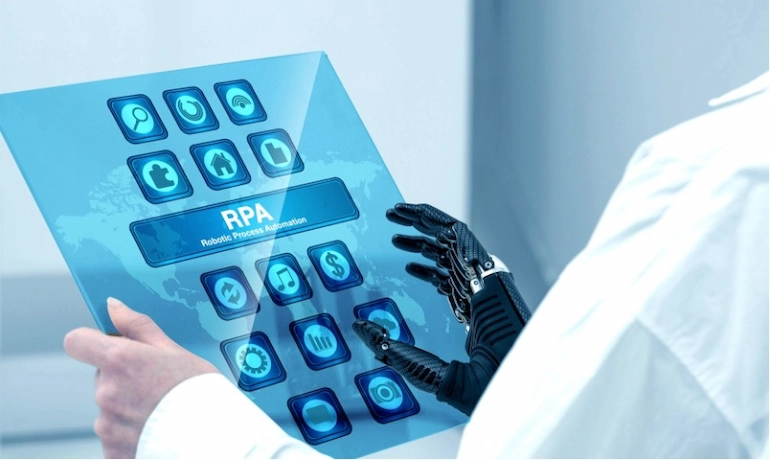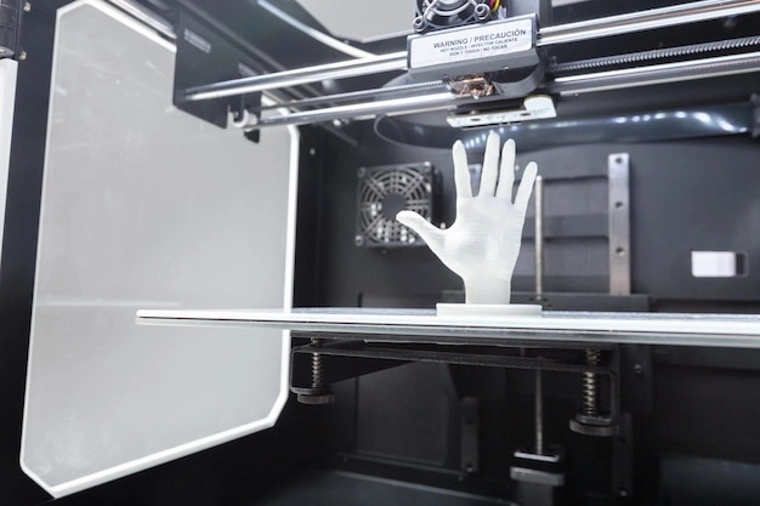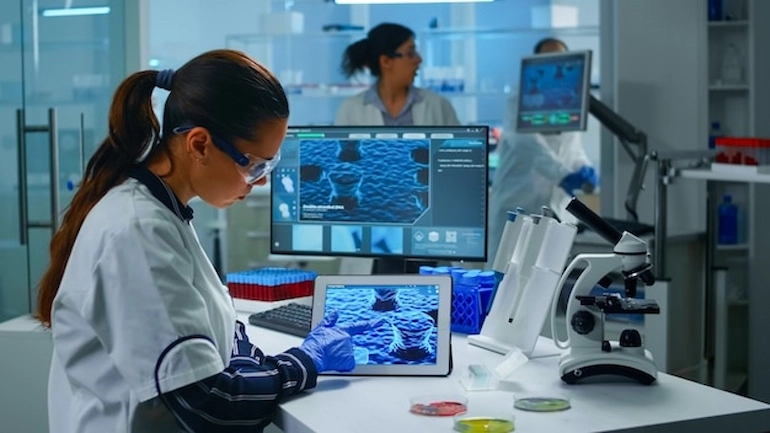
The healthcare industry is facing critical shortages across multiple areas, including personnel, medical expertise, and technological resources. Even though the COVID-19 pandemic has passed, these challenges persisted and are expected to worsen over time, preventing healthcare professionals from delivering optimal patient care. In light of these obstacles, adopting digital innovations offers a promising approach.
Alleviating staff shortage with the power of Robotic Process Automation (RPA)
The healthcare sector is grappling with staff shortages. According to research, there is a projected global shortfall of 18 million health workers by 2030. However, healthcare employees usually spend time on administrative tasks (such as scheduling appointments and processing claims), further aggravating staff shortages. A study found that 68% of internal medicine residents spent more than 4 hours daily on clinical documentation in the inpatient setting – the amount of time that could be allocated to deliver patient care. Moreover, the cost of managing administrative tasks is more remarkable compared to delivering patient care. In the US, the healthcare industry’s administrative costs account for twice the amount that the country spends on cardiovascular disease care annually and three times on cancer care.
Therefore, Robotic Process Automation (RPA) can help healthcare providers free up manual efforts and alleviate staff shortage by:
Automating claim processing
Claim processing is time-consuming for healthcare employees, especially for short-staffed medical centers. The Canadian Federation of Independent Business's report on Patients Before Paperwork reveals that Canadian doctors spend 18.5 million hours annually on unnecessary administrative work — the equivalent of 55.6 million patient visits. As healthcare professionals usually face difficulties entering data in various formats, claim processing can be streamlined by RPA bots. RPA can automatically recognize visual layouts and labeling data and enter them into claims processing systems. Furthermore, RPA bots are programmed to automatically extract data from various internal and external systems such as Electronic Health Records (EHR), patient databases, and insurance portals.

Healthcare professionals can utilize RPA to automate administrative tasks.
Therefore, healthcare providers can quickly check patient eligibility, verify coverage details, and accelerate the authorization process to minimize delays in claim processing. Once claims are validated, RPA can handle the submission process by automatically sending claims to the appropriate payers through electronic data interchange (EDI) or other submission channels. As the healthcare industry collectively spends 2.1 billion USD annually on poorly executed and error-prone manual data management, RPA is a viable solution to eliminate traditional claim processing and solve medical staff shortages.
Automating appointment scheduling
Automation technology offers an innovative solution for appointment scheduling. Specifically, patients can schedule their appointments via an online portal or chatbot interface. The bot then accesses the healthcare provider's calendar in real time and displays available slots to the patient. Once the patient selects their availability, the confirmation email will automatically be sent to patients and doctors.
The automated chatbots can be integrated with the doctors’ schedule, which helps medical centers keep track of their patients and reduce manual scheduling. Since NHS loses approximately £216 million through missed general practice appointments with 15 million GP appointments wasted each year due to no-shows, automation technology can improve staff allocation, minimize manual efforts, and improve customer experience.
Healthcare employees can also rely on RPA to automatically send out reminders in the allotted time with the patients. Thus, healthcare workers can minimize their workflows and save employees’ efforts rather than investing time in administrative work.
Harnessing 3D printing and predictive analytics to resolve equipment shortage
Another challenge faced by the healthcare industry is insufficient medical equipment. Notably, recent data highlighted a concerning surge in backorders for critical supplies compared to pre-pandemic levels. Hospitals, which typically dealt with 400-500 daily back-ordered items, are now facing an increased range from 800 to 1000. Furthermore, approximately 20% of essential medical supplies are experiencing scarcity rates exceeding 5%, prompting hospitals to continuously seek vital items amid this challenging landscape.
Therefore, innovative digital solutions have emerged to solve equipment shortages for medical centers, including:
3D printing technology
In areas where medical facilities might lack access to healthcare equipment, 3D printing allows for the local, on-demand production of necessary medical hardware, from surgical tools to patient-specific orthopedic devices. This capability is even more beneficial in remote regions, where traditional supply chains may struggle to deliver. By producing equipment directly at the point of care, healthcare providers can significantly reduce the waiting time for essential medical devices.

3D printing technology can alleviate medical device shortage.
The adaptability of 3D printing also supports decentralized production, enabling components to be created on-demand and at the locations where they are most needed. This decentralization can reduce the delays associated with centralized manufacturing and distribution networks. By introducing a more efficient way to produce medical devices, 3D printing has the potential to resolve the shortage of medical equipment and enhance access to essential healthcare resources.
Predictive analytics for device management and maintenance
Predictive analytics can forecast demand for medical devices based on historical usage data, patient demographics, and other relevant factors. Healthcare facilities can optimize their inventory levels and mitigate the risk of medical equipment shortages by predicting future needs more accurately. In addition, maintenance staff can be informed to schedule preventive maintenance activities or replace worn-out components before they cause equipment failures. Consequently, healthcare providers can reduce machine breakdowns by 70% and lower maintenance costs by 25%, all thanks to predictive analytics. Especially, predictive analytics can extend the machinery’s longevity, resulting in fewer breakdowns, reduced need for replacements, and decreased costs.
Solving the need for medical training with Generative AI
Alongside the need for additional healthcare equipment and understaffed medical facilities, some hospitals encounter the lack of medical training. As emerging healthcare workers prepare to enter an ever-evolving field, the limitations of traditional educational models have become increasingly apparent. During this critical time, the call for new and innovative training solutions is critical to ensure that future students or employees are fully equipped with necessary skills and knowledge necessary to thrive.

AI can assist medical institutions in upskilling employees.
Hence, generative AI, such as ChatGPT, is the appropriate measure to bridge this knowledge gap by providing answers related to healthcare, from simple to complex questions. Generative AI can recommend training programs to upskill practitioners by suggesting relevant resources and designing medical courses. Moreover, it can identify specific areas of improvement and tailor training recommendations to suit the needs of inexperienced doctors. These recommendations may include various educational materials, online courses, or and practical exercises to enhance clinical expertise. Through personalized training programs, Generative AI can alleviate the lack of expertise in the medical field.
It is also essential for institutions to embrace artificial intelligence as a useful tool to support healthcare education. Fostering a culture of using digital solutions such as AI will encourage healthcare members to pursue further skills development and improve patient care. Indeed, a study found that 89.6% of surveyed participants support the integration of AI in medical education.
The joint effort of humans and healthcare digital solutions
While digital solutions have made significant strides in the healhtcare sector, it is crucial to acknowledge the combined strength of both technologies and human expertise. In complicated medical scenarios, humans still remain essential, where technology serves as a valuable tool to provide temporary measure for knowledge, equipment, and staff shortages.































